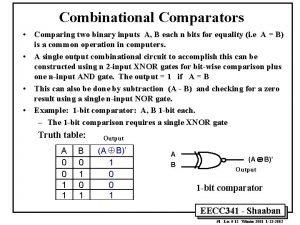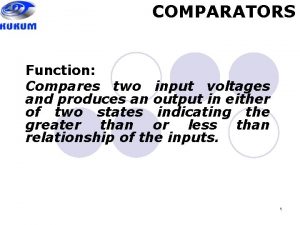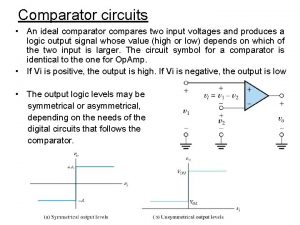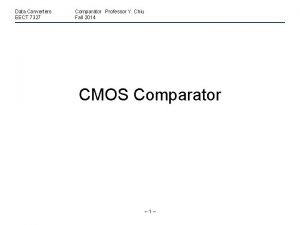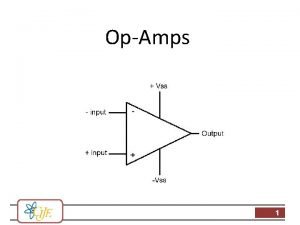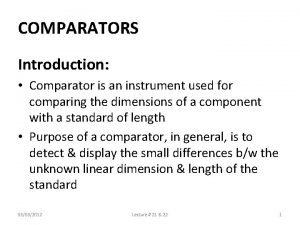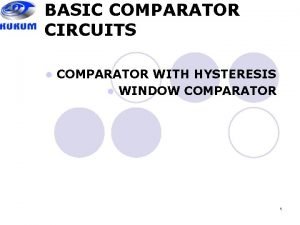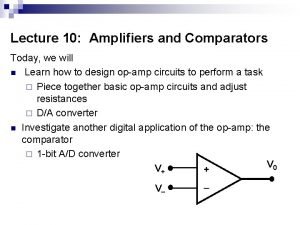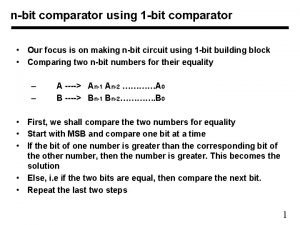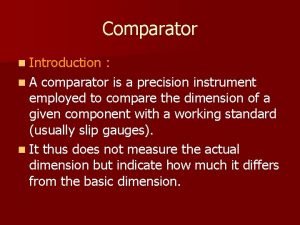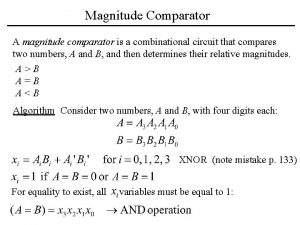Comparator What is a Comparator 2 nd most

























- Slides: 25

Comparator • What is a Comparator? – 2 nd most widely used building block after Op Amp – The comparator is essentially a 1 -bit analog to digital converter. • Input is analog • Output is digital – Types of comparators: 1. Open-loop (op amps without compensation) 2. Regenerative (use of positive feedback - latches) 3. Combination of open-loop and regenerative comparators 1

Circuit symbol: Ideal I-O transfer curve Actual I-O transfer curve 2

Static Specs • Static Characteristics – Gain • Slope of the linear region • =(Voh-Vol)/(Vih-Vil) – Output high and low states • Voh, and Vol • Needs to be clearly defined as digital 1, 0 – Input resolution • Vih – vil • Vi_range / (Vih-Vil), can be expressed as bits – Offset • (Vih+Vil)/2 – Noise 3

Comparator Noise of a comparator is modeled as if the comparator were biased in the transition region. Noise leads to an uncertainty in the transition point which causes jitter or phase noise. 4

Offset cancellation 1_advanced Switches off slightly ahead of Φ 1 to minimize charge injection. 5

Offset cancellation 6

Must have stability during phi_1 Book’s solution: compensate during phi_1 Chapter 10 Figure 05 7

Alternate solution: Offset cancellation by stage VDD vs Vin+ vin 2 8

Propagation Time Delay Rising propagation delay time: Propagation delay =(Rising delay + Falling delay)/2 or = Rising delay + Falling delay 9

Single pole response of amplifier 10

Time delay due to dynamic response 11

Slew Rate of a Comparator If the rate of rise or fall of a comparator becomes large, the dynamics may be limited by the slew rate. Slew rate comes from the relationship, i = Cdv/dt where i is the current through a capacitor and v is the voltage across it. If the current becomes limited, then the voltage rate becomes limited. Therefore for a comparator that is slew rate limited we have, tp = ∆T =∆V/SR =(VOH- VOL)/2·SR where SR = slew rate of the comparator. 12

Find the propagation delay time of an open loop comparator that has a dominant pole at 103 radians/sec, a dc gain of 104, a slew rate of 1 V/µs, and a binary output voltage swing of 1 V. Assume the applied input voltage is 10 m. V. Solution The input resolution for this comparator is 1 V/104 or 0. 1 m. V. Therefore, the 10 m. V input is 100 times larger than vin(min) giving a k of 100. Therefore, we get tp =1/103 ln(2· 100/(2· 100 -1)) = 10 -3 ln(200/199) = 5. 01µs For slew rate considerations, we get tp =1/(2· 1 x 106) = 0. 5µs Therefore, the propagation delay time for this case is the larger or 5. 01µs. But for Vin=Vin(min), tp =1/103 ln(2/(2 -1)) = 693µs. 13

Two-Stage Comparator An important category of comparators are those which use a high-gain stage to drive their outputs between VOH and VOL for very small input voltage changes. The two-stage op amp without compensation is an excellent implementation of a high-gain, open-loop comparator. 14

Delay time 1/(√Av(0)) 15

Push-Pull Comparators Push-pull output higher slew rate 16

Driving Large Capacitive Load 17

18

19

20

21

22

23

24

25
 4 bit comparator truth table and logic diagram
4 bit comparator truth table and logic diagram Threshold comparator
Threshold comparator Upd
Upd Precision comparator
Precision comparator Comparator adder
Comparator adder Sahli's comparator uses
Sahli's comparator uses Double bounded comparator
Double bounded comparator Ideal comparator
Ideal comparator Plastic shrinkage cracking repair
Plastic shrinkage cracking repair Applications of comparator
Applications of comparator Video spectral comparator (vsc)
Video spectral comparator (vsc) Comparator design pattern
Comparator design pattern Java comparator comparing boolean
Java comparator comparing boolean Op amp
Op amp Optical comparator definition
Optical comparator definition Sigma comparator
Sigma comparator Reed type mechanical comparator
Reed type mechanical comparator Design a combinational circuit
Design a combinational circuit Window comparator with hysteresis
Window comparator with hysteresis Comparator with op amp
Comparator with op amp N bit comparator
N bit comparator In the name of allah, the most gracious, the most merciful
In the name of allah, the most gracious, the most merciful Most general to most specific classification
Most general to most specific classification In the name of god the most gracious the most merciful
In the name of god the most gracious the most merciful The most
The most The arrangement chapter 9
The arrangement chapter 9
